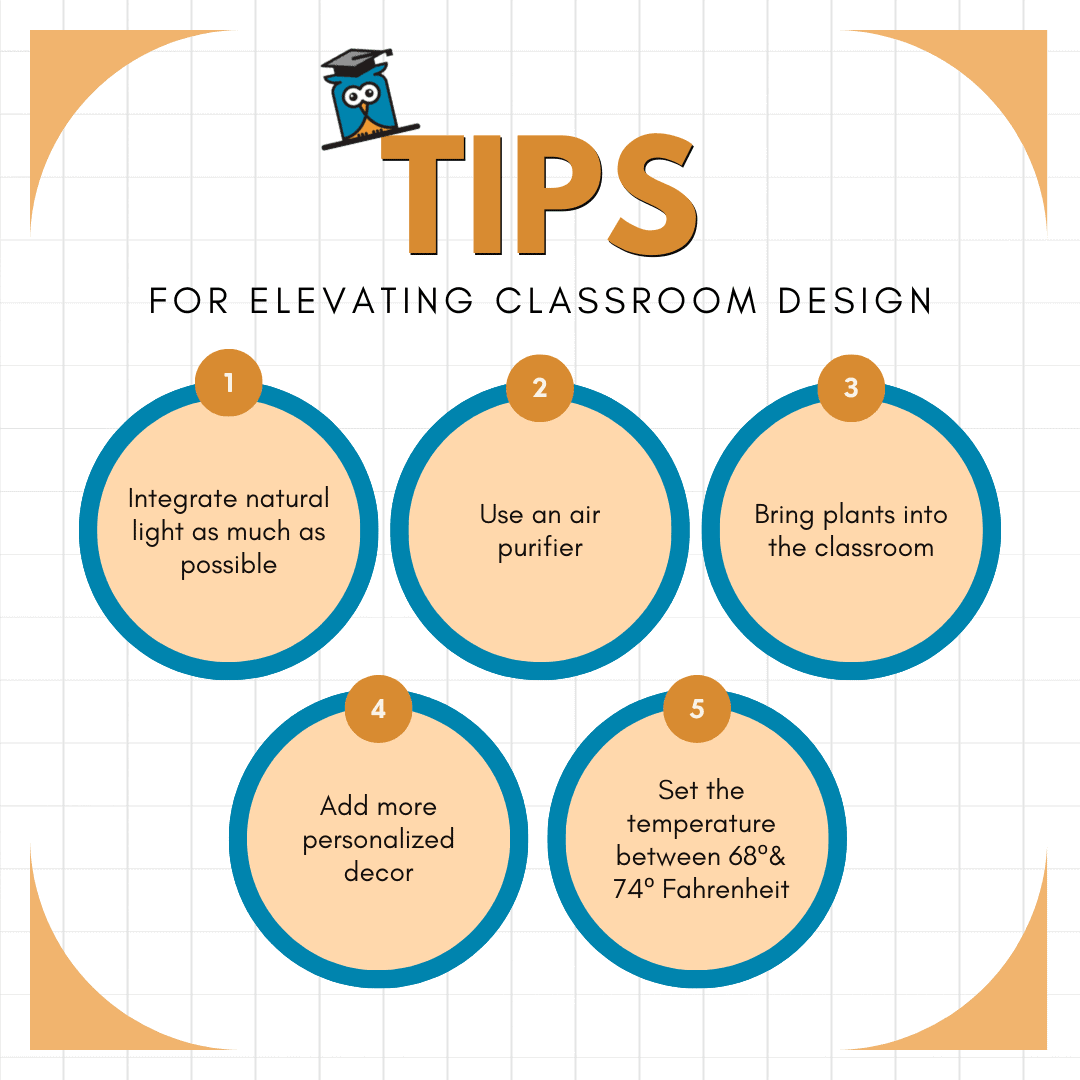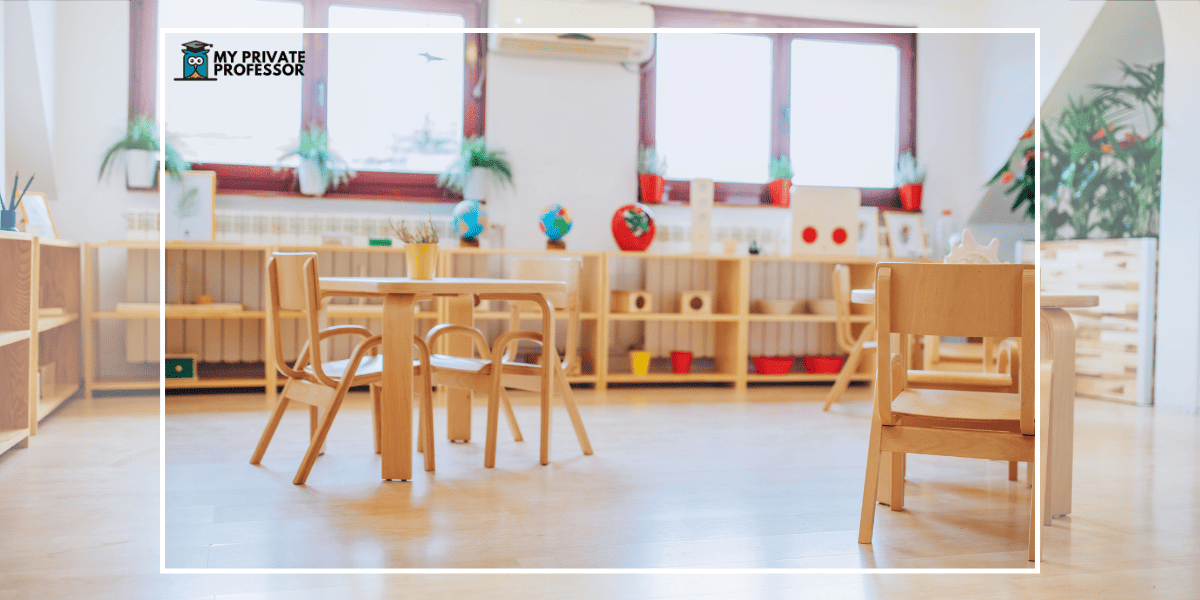Marie Kondo said, “Life truly begins after you have put your house in order.”
Whether she knew it or not, Kondo was speaking to the needs of the student house — or, the classroom. As it seems, the classroom structure and design plays a critical role in student success.
This can be great news for teachers! By simply adjusting certain elements in the classroom, teachers can boost student performance — and without adding any work to students’ plates.
Below are some important classroom design factors that can affect academic outcomes and student learning, and suggestions on how to leverage them to improve learning outcomes.
Classroom lighting
According to a 2020 review of 130 studies, lighting is one of the most important characteristics to consider in creating a classroom environment that elevates learning.
The first thing to think about here is natural light. When professional designers and decorators discuss lighting, they almost always highlight the importance of natural light — and for good reason.
A 1999 report on more than 2,000 classrooms found that students in classrooms with lots of natural light progressed more in reading and math than students who were exposed to less sunlight.
Perhaps part of the power of natural light lies in the fact that often, natural light goes hand in hand with views of nature. And research shows that when students have views of natural green spaces (nature), they report feeling less stressed and more focused on their tasks.
Additionally, research shows that students who are exposed to more daylight maintain a better regular sleep cycle. And when students have better sleep schedules, they have an easier time staying focused and engaged in class.
Whenever possible, teachers should allow students to face or be near windows that let in natural light.
Classroom air quality
Another factor that teachers should consider when evaluating and elevating the classroom is air quality. In life, we function better when we’re taking in higher-quality oxygen. So of course, this applies to the classroom, where students are expending great amounts of cognitive energy on a daily basis.
When you take in oxygen, the air goes directly to your brain. When you take in better air, the result is that your brain will function better. You can think about this like you would the difference between filling your car with premium and regular gas.
When you get premium, you’ll likely have better gas mileage and lower emissions. When you get the higher-tiered air quality, similarly, your brain will be able to run better and for longer. Essentially, this means you’ll be able to focus better and likely, for longer periods of time.
Indeed, research continually shows that air pollution is linked to cognitive impairment.
Unsurprisingly, cognitive impairment can hinder academic performance. A study that analyzed pollution data from over 10,000 US school districts found a direct, negative association between air pollution and academic performance.
Additionally, research has found that exposure to low-quality air is related to declining student attendance and also affects teachers’ ability to teach. All in all, the message here is clear: when students have better air quality, they learn better. And when teachers are exposed to better air quality, they will teach better.
Here are some things teachers can do to better evaluate and improve air quality in the classroom:
- Use air purifiers
- Install a ventilation system
- Use whiteboards instead of chalkboards
- Grow toxin-removing plants in the classroom
Classroom decorations
There’s a reason why, when you come across articles on the internet that discuss how to elevate your workspace to inspire productivity, you’ll find encouragement to add decorations that will elevate your headspace.
Often, we work and learn better when we’re surrounded by items and decor that provide us with positive feelings (happiness, calmness, excitement, inspiration, admiration, etc.).
In the classroom, plants are one of those items that can yield some of these feelings (likely, subconsciously).
A 2020 study found that adding potted plants to high school classrooms led to students paying more attention in class and rating both the lessons and their teacher more highly.
Moreover, extensive reports have shown that exposure to nature can elevate student outcomes by improving focus, mediating stress, and elevating interest.
By adding plants to the classroom, teachers can help students improve their attention, decrease their stress, and enhance their interest around any given lesson.
(Meanwhile, a plethora of research shows that plants in the classroom can improve sustainability within schools. Win-win!)
In addition to plants, it’s important to surround students with decorations that make the classroom feel more intimate. In a 2015 study, researchers found that intimate, personalized spaces led to better learning outcomes.
Teachers can craft a more intimate learning space by showcasing items related to students’ non-academic interests (photos, posters, awards, etc.).
By just adding some indoor plants and swapping out some generic decorative items with personalized ones, teachers can significantly enhance their classroom’s energy — and in turn, elevate the learning experience.
Classroom seating
Seating arrangement, another key factor in classroom arrangement, plays a significant role in developing a positive learning environment.
As it stands, research shows that a good seating plan benefits students in many ways, including:
- Improving focus
- Promoting positive academic behaviors (i.e., raising hands instead of interrupting)
- Fostering better peer relationships
But what exactly makes a good seating plan?
In terms of the seating arrangement type, we often seem to be split somewhere down the middle regarding whether or not students should get to choose their seats.
To some extent, research shows that assigned seating can be beneficial to student learning and development.
For instance, a 2013 study found that intentionally separating close friends can majorly reduce classroom disruptions. Additionally, a 2021 study found that assigned seating can spur students to form new friendships with those who they otherwise likely wouldn’t bond.
However, we can all recognize that students benefit from moderate amounts of freedom and agency in the classroom. When students have a say in in their learning, they will be more inclined to engage with the material and their peers.
So when considering classroom seating arrangements, teachers should try to provide a solid mix of assigned and flexible seating. For example, when it comes to review days, where active listening and participation are major priorities, it probably makes more sense to use assigned seating.
But when you’re dealing with a more informal class day, where you’re doing end-of-year presentations, flexible seating could work just fine.
Classroom temperature
Temperature is a tricky one. There seems to be this common belief that students need to be in colder air to learn better — and that warm air causes drowsiness.
While warm temperatures can, in fact, cause exhaustion (your body basically works overtime to function), it’s a common learning myth that cold air is better than warm when it comes to learning environments.
Actually, a classroom that is either “too cold” or “too warm” can hinder students’ learning.
Indeed, a 2014 study found that generally, both excessively cold and hot temperatures can directly affect students’ learning.
Researchers have found that when students are hot, they are less productive in class. For instance, one study found that on a hot day, students scored significantly lower on the state’s standardized state tests compared to on a cooler day.
Meanwhile, research has found that students may spend less time studying and have lower attendance rates in excessively cold temperatures.
So really, as research shows, there’s a temperature range somewhere in the middle of cold and warm that’s supposed to be ideal for learning. And that is between 68° and 74°.
Final thoughts
We often solely consider things like intelligence, discipline, and focus when considering the recipe for academic achievement. But in reality, classroom design and organization can also play a significant role in driving students to success.
Cultivating the ideal classroom design is like finding the perfect mattress. It’s most likely going to be a trial-by-error experiment to some extent. But by taking the time to look at what they can change for the better, teachers can get one step closer to crafting the perfect classroom.







